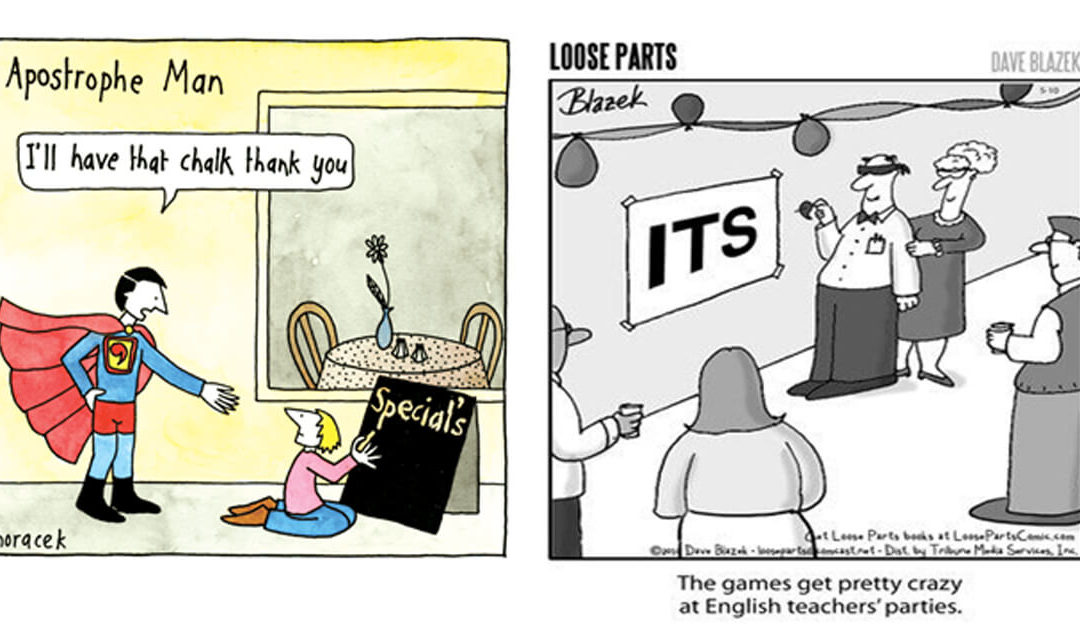Welcome to the first Weekly Writing Tip. Today’s topic is my biggest pet peeve – the correct (and incorrect!) use of apostrophes. The poor apostrophe is probably the most misused punctuation mark in the English language.
Repeat after me: An apostrophe + “s” is NOT used to make a plural.
Apostrophes are used to: (1) show possession or ownership, and (2) to combine two words by leaving out a letter or letters, i.e., construct a contraction.
Possession
To indicate possession or ownership, add “ ’s ” to the end of the person’s name or the noun:
Emma’s new sneakers greatly impressed the old women at her sister’s wedding.
If the person’s name ends with an “s”, add both the apostrophe and “s”.
Dr. Jones’s lab publishes about 10 papers annually.
James’s dog makes a lot of noise.
If the noun is singular and ends in “s”, add “ ’s ”.
My boss’s job at the university was eliminated due to restructuring.
The class’s average grade was impressive.
If the noun is plural and ends in any letter other than “s”, then add “ ’s ”.
The women’s degrees were in chemistry.
The children’s favourite game was Hide and Seek.
If the noun is plural and ends in “s”, then add only an apostrophe to indicate possession:
Plural: Both bananas’ peels had turned brown.
Plural: The athletes’ uniforms were smelly after the game.
Singular: The athlete’s uniform was smelly after the game.
Contractions
An apostrophe is also used in contractions, to indicate where a letter has been left out when two words are combined:
It’s = it is OR it has
Couldn’t = could not
Wouldn’t = would not
Won’t = will not
Don’t = do not
Doesn’t = does not
Didn’t = did not
DJ didn’t realize that you can’t fill a balloon with hot chocolate.
I couldn’t believe my eyes.
Contractions are typically limited to casual speech or writing and are not used in formal and professional writing, such as scientific and medical manuscripts.
Contractions versus Possessive Pronouns – it’s versus its
The single biggest confusion around apostrophe use is with the words “its” and “it’s”.
“It’s” is a contraction of it + is.
It’s very busy in the emergency department today.
I just realized it’s time to go!
“Its” is a possessive pronoun and does not have an apostrophe:
The dog pulled on its leash.
The suspension separated into its components with centrifugation.
The same principles apply to “you’re” versus “your”, and “who’s” versus “whose”.
Contraction: You’re the best teacher I’ve ever had. (= You are the best … )
Possessive Pronoun: Remember to bring your calculator to the exam.
Contraction: I wonder who’s going to present the abstract at the conference. (= … who is going to present … )
Possessive Pronoun: Whose turn is it to bring snacks to the meeting?
If you’re unsure whether to use an apostrophe, ask yourself if two separate words are being combined into one contraction. If yes, then use an apostrophe. If no, then don’t use an apostrophe.
Finally, remember these important last words: An apostrophe + “s” is NOT used to make a plural. Of note, the one exception (there’s always an exception in the English language) is when referring to lowercase letters:
Mind your p’s and q’s!
Thank you for indulging my pet peeve in this first Weekly Writing Tip. I welcome your comments and feedback, and I look forward to receiving topic suggestions for future tips.


Thanks for this great article, Dagmar. It has been a while since I sought your grammatical opinion and I have one that stumps me now.
Is it:
A period of disability of four months duration…
Or
….of four months’ duration….?
Hi Valerie, great question!
An apostrophe is used for the genitive case, i.e., when a phrase can be
rewritten with “of”. Therefore, yes, one uses an apostrophe in this case:
A period of disability of four months’ duration – i.e., a period of
disability with a duration of four months.
Other examples:
– The job requires five years’ experience.
To avoid the apostrophe:
– The job requires five years of experience.
– In October he will begin a year’s sabbatical.
To avoid the apostrophe:
– In October he will begin a year of sabbatical.
– The law requires that an employee is given two weeks’ notice of a layoff.
To avoid the apostrophe:
– The law requires that an employee is given two weeks of notice of a
layoff.
Hope this helps!
– Dagmar.
Sharing this with my students… they especially need to learn that contractions should not be used in academic writing. I see a lot of “could’ve” and “should’ve” in their discussions every year.
Thanks Ms De Jong! Happy to hear this post is helpful. If there are any other topics that would be particularly beneficial for your students, please let me know. I’m open to ideas for future blogs.
Very detailed and informative blog. Who knew there was so much depth to the apostrophe? I was particularly challenged by the singular noun and the genitive cases. Well done.
Thank you Ms. Osamusali. I’m pleased to hear you found the article helpful.